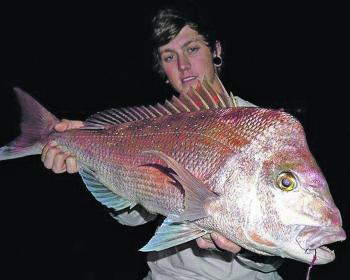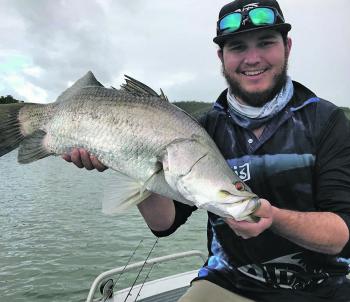At last the weather patterns seem to be settling into ‘normal’ conditions for this time of year. The aftermath of cyclone Debbie is still being felt throughout the area but gradually life returns to normal.
Debbie certainly livened up the fishing around Mackay. The massive flooding of our creeks and estuaries has seen an explosion of bait species including a good run of prawns. As every angler knows, the best fishing is had when the food chain is in good shape and that is surely the situation now in our systems.
Even though we’ve had a couple of cold snaps (below 10°C), there has been a surprising number of good barra caught in the creeks, both north and south of the city, and also in the Pioneer River in the city reaches. These barra have stayed on the chew with the increase in bait and the extended summer/autumn temperatures. I expect the barra fishing to drop back during June as our real winter sets in.
One recent notable barra capture was an 84.8cm fish caught by A. Caruso in the Pioneer River bearing the tag number V90338. This fish was stocked by MAFSA on 27/09/2015 and grew 58.2cm in 559 days. The barra was caught 6km downstream of the stocking site and had gone over the Dumbleton Weir during flood times. This barra is the largest barra out of the 1000 stocked and tagged by MAFSA in September 2015 to be recovered and was again released by the angler, so it will be interesting to see where it turns up next.
Barra will be much harder to catch during June. On those rare calm days with higher water and air temperatures they will still be active and can be harassed into hitting a lure with persistent working of a snag or drain/channel. Live bait anglers will find barra in the usual haunts in Constant Creek down towards the mouth at the barra hole and around the rock bars in the Seaforth/St Helens areas. The NFZ appears to be working well with reports of better than average size fish coming from the St Helens area in particular.
South of Mackay the best bet for a salty barra is probably going to be Rocky Dam Creek near Koumala, which is serviced by a concrete ramp. It gets fairly muddy so be careful. Visitors should also heed the crocodile warning signs as there are several resident crocs in the system.
With the onset of the cooler weather we are also likely to get more threadfin and blue salmon in our creeks. While the big threadies are usually lone fish or in small schools, the blues will often school up in large numbers and a couple of anglers can rapidly catch plenty.
Blues need to be well looked after if being kept for the table and should be bled and iced down immediately on capture. With a hot bite going it can be difficult to stop fishing and take care of the catch, but the end result on the plate is worth taking the little bit of extra time with the catch.
Threadies like live baits such as prawns and small mullet, but don’t discount fresh live yabbies either. At times they will ignore fresh live baits and take slab baits. With several lines out, a variety of baits can be employed. Blues have a preference for small prawns or yabbies.
For the lure angler, both species will smash prawn imitations and the clear Fuze 55mm is a good all rounder. Others like the Prawnstar and Zerek soft prawns also work well. Soft vibes and small metal vibes will catch both species, as will many of the grub type lures. Your best bet is to check in with the local tackle shops for the good oil on what is working and where the fish are being caught.
Winter time also sees pikey bream featuring more in the creek anglers’ catches. Towards the end of winter the fish will spawn. Calm winter weather will let the alert angler spot the pikeys milling around mangrove roots and among the leaves of any freshly fallen mangrove lying in the water. A small lure or bait presented to them will often have four or five fish competing for the offering. Watch the legal length of these – many of them are undersize.
During June we should also see winter whiting moving around our estuaries and creeks and locals will keep an eye on activity on the Forgan Bridge in the heart of Mackay as this is a sure sign that the whiting are biting. Lots of anglers fishing from the bridge on a night time run up tide is a good sign there are whiting about. Some genuine elbow-slappers are caught each year in the river with worms and yabbies or small strips of squid being the preferred baits.
June also brings the Mackay Show and snapper. Anglers have already started to catch the odd snapper. Initially the snapper will be caught further south offshore from Cape Palmerston and the islands in that general area. Over the next few weeks they’ll start showing up around Hay Point and the islands out from the river mouth. The odd fish is also caught from the harbour walls. Generally the snapper are a boaties’ fish.
The local tackle shop staff will know when the main migration of snapper arrive in our local waters and will also advise you on bait and lures that work. Snapper are being targeted more and more with soft plastics and soft vibes in the larger sizes. It’s best to have a variety of sizes and colours on hand.
The other essential element for success is to have a quality sounder to pick up bait and snapper close to the bottom. As a rule, snapper will be in a fairly small area. By watching for other boats at anchor, you have a fair idea of the spots to start fishing. A good sounder is invaluable.
My picks for fish to chase during June would be snapper if the weather is kind, or threadies and blue salmon in the creeks. As always, Mackay offers plenty of options. We have mild winters here in paradise, so why not join us?
In the freshwater, the Maverick World Sooty Championship has been another great success at Eungella Dam with local tournament angler Dan Grech recording his third win with consistent high scoring fish. See the full article in the tournament news section and full results are posted on MAFSA’s Facebook site.
For June the sooties will be the mainstay on the freshwater front, as they stay active in both the dams and the river. Eungella dam has been topped up with just over 80,000 sooties that MAFSA bred in the hatchery. Congratulations to hatchery supervisor Kieron Galletly and his team of workers on an outstanding result.
Reads: 3599
Chilly weather in Mackay did not stop Clinton Hassan scoring these two threadies on live prawns worked along the sloping bank in the background.

Early season snapper like this ripper held by Tom Capewell are now being caught around the Hay Point area south of Mackay.

Aaron Sturdy took advantage of the masses of small prawns in Constant Creek to score this beaut barra on a 55mm Fuze Prawn drifted down onto a small rock bar.




